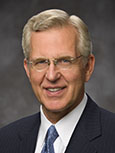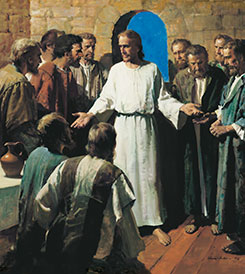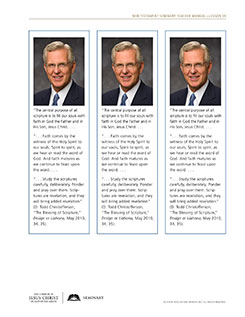Lesson 59: Luke 24
Introduction
On the third day after Jesus Christ’s death, angels at the tomb announced His Resurrection to a group of women. Upon hearing the women’s report, some of the disciples doubted the possibility of the Savior’s Resurrection. Two disciples traveled to Emmaus and, without recognizing the resurrected Lord, spoke with Him along the way. Jesus later appeared to His Apostles and others, showed them His resurrected body, and commissioned them to preach repentance and be witnesses of Him.
Suggestions for Teaching
Luke 24:1–12
Angels announce to a group of women that Jesus Christ is risen
If you are unable to show the video, invite students to imagine that they had been at the tomb when Jesus was placed there and had seen the stone being rolled in front of the doorway. Ask them to imagine the thoughts and feelings they might have had there. Invite a student to read Luke 24:1–4 aloud. Ask the class to follow along, looking for what the women discovered when they returned to the tomb three days later.
After showing the video clip or reading verses 1–4, ask:
- • What did the women find at the tomb?
- • How might you have reacted if you had seen the angels standing at the opened tomb?
Invite a student to read Luke 24:5–8 aloud. Ask the class to follow along, looking for what the angels told the women. Invite students to report what they find.
Summarize Luke 24:9–10 by explaining that the women left the tomb and told the disciples what they had seen and heard.
Invite a student to read Luke 24:11 aloud, and ask the class to look for the Apostles’ reaction to the women’s words. Invite students to report what they find.
Explain that after hearing the women’s report, Peter and John ran to the sepulchre and found that Jesus’s body was gone (see Luke 24:12; John 20:1–4).
Luke 24:13–32
The risen Lord speaks to two disciples on the road to Emmaus
Ask students to ponder a time when they, like the disciples in this account, have struggled to believe a gospel concept.
Explain that in Luke 24:13 we learn that two disciples left Jerusalem “that same day,” traveling about 6–7.5 miles (10–12 kilometers) “to a village called Emmaus.” Studying their experience on the road to Emmaus can help us know how to strengthen our testimonies of Jesus Christ and His gospel.
Invite a student to read Luke 24:14–17 aloud, and ask the class to look for who joined the two disciples as they walked.
- • Who joined the disciples as they traveled?
- • Why did the disciples not recognize Jesus? (Explain that the word holden [verse 16] means restrained or covered.)
Point out that in this video, we do not hear what Jesus taught the disciples as they walked. Invite a student to read Luke 24:27 aloud, and ask the class to look for what Jesus taught the disciples.
- • What did Jesus teach the disciples? What tool did He use to teach about Himself?
- • According to Luke 24:32, how did the Savior’s teachings from the scriptures affect the two disciples?
- • What does it mean that the disciples’ “heart[s] burn[ed] within” them? (The Holy Ghost testified that the teachings about Jesus in the scriptures were true.)
Invite students to ponder what the disciples might have learned from Jesus’s using the scriptures to teach them rather than simply revealing who He was. You might ask a few students to share their thoughts.
- • What can we learn from these verses about the effects of our own scripture study? (After students respond, write the following principle on the board: As we study the scriptures, we invite the Holy Ghost to teach us of Jesus Christ.)
- • Besides a burning in our hearts, how else would you describe what we might experience as the Holy Ghost testifies of Jesus Christ?
Ask students to locate a scripture that has helped them feel the Holy Ghost teaching them about Jesus Christ. Invite them to share their scriptures and the effects of what they have felt. You may also want to share a scripture that has helped you personally.
Remind students that even though it is important to read the New Testament for seminary credit, it is even more important to study the scriptures in a way that the Holy Ghost can strengthen their testimonies of the Savior.

“The central purpose of all scripture is to fill our souls with faith in God the Father and in His Son, Jesus Christ. …
“… Faith comes by the witness of the Holy Spirit to our souls, Spirit to spirit, as we hear or read the word of God. And faith matures as we continue to feast upon the word. …
“… Study the scriptures carefully, deliberately. Ponder and pray over them. Scriptures are revelation, and they will bring added revelation” (D. Todd Christofferson, “The Blessing of Scripture,” Ensign or Liahona, May 2010, 34, 35).
© 2015 by Intellectual Reserve, Inc. All rights reserved.
Ask a student to read the statement by Elder Christofferson aloud. Invite the class to follow along, looking for ways in which they can improve their personal scripture study.
Invite students to set a goal to study their scriptures in ways that invite the Holy Ghost to increase their faith in and knowledge of Jesus Christ. You might suggest that they write this goal on the back of the bookmark so that they can use it as a reminder during their scripture study.
Luke 24:33–53
Jesus appears to His disciples and shows them His resurrected body
Invite two students to bring their scriptures to the front of the class to help role-play a scene that portrays missionaries approaching someone’s door. Instruct them to knock. Pretend to open a door and greet them. Tell them to introduce themselves. After they do so, say something like the following:
“I have a question. A lot of people I know do not believe in life after death. Some of them say they believe in Jesus Christ but do not believe He was resurrected with a physical body. They say He continued to live only as a spirit. What do you believe about the Resurrection of Jesus Christ?”
Give the two students time to answer the question.
Point out that Luke 24:36–39 is a scripture mastery passage and can help teach about the literal Resurrection of Jesus Christ. Provide context for this passage by explaining that the disciples who were with Jesus on the road to Emmaus immediately returned to Jerusalem and related their experience to the Apostles and other disciples (see Luke 24:33–35). While they were talking, the Savior appeared (see verse 36).
Invite one of the students who helped role-play to read Luke 24:36–39 aloud. Ask the class to follow along, looking for evidence that Jesus was literally resurrected and has a body of flesh and bones.

- • What did Jesus invite His disciples to do to help them understand that He was not merely a spirit but had a physical body? (Consider displaying the picture Jesus Shows His Wounds [Gospel Art Book (2009), no. 60; see also LDS.org].)
- • How do you think you would feel if you had been present when Christ appeared to His disciples?
Thank the students who helped role-play, and ask them to sit down. Invite a student to read Luke 24:40–43aloud. Ask the class to follow along, looking for what else Jesus did to show that He had a tangible (or physical) resurrected body.
- • What else did the Savior do to show that He had a resurrected body?
- • What doctrines can we learn from these verses? (Students may identify a variety of doctrines, but be sure to emphasize that Jesus Christ has a resurrected body of flesh and bones. Write this doctrine on the board.)
- • Why is this doctrine important to understand and believe?
Invite a student to read the following statement aloud:
“Through the Atonement of Jesus Christ, all people will be resurrected—saved from physical death (see 1 Corinthians 15:22). Resurrection is the reuniting of the spirit with the body in a perfect, immortal state, no longer subject to disease or death (see Alma 11:42–45). …
“An understanding and testimony of the resurrection can give you hope and perspective as you experience the challenges, trials, and triumphs of life. You can find comfort in the assurance that the Savior lives and that through His Atonement, ‘he breaketh the bands of death, that the grave shall have no victory, and that the sting of death should be swallowed up in the hopes of glory’ (Alma 22:14)” (True to the Faith: A Gospel Reference[2004], 139, 140).
- • What are some examples of trials that the hope of our own resurrection could help us endure?
Ask a few students to testify of the Savior’s Resurrection and to explain why the doctrine of the Resurrection is important to them.
Invite a student to read Luke 24:44–53 aloud. Ask the class to listen to the Savior’s words as though they had been part of the group of disciples who were with Him and to consider which teachings may have been most meaningful to them. Invite a few students to share their thoughts about the teachings in these verses.
Conclude by testifying of the truths you have discussed.
 Scripture Mastery—Luke 24:36–39
Scripture Mastery—Luke 24:36–39
To help students memorize Luke 24:36–39, divide the class into four groups. Assign a different verse from this passage to each group, and instruct the students in each group to work together to memorize their assigned verse. After a few minutes, ask each group to recite their assigned verse in order of the verses. You may want to invite students to recite their verses again for the next few class periods until the entire passage becomes familiar to everyone.
Commentary and Background Information
Luke 24:11. “They believed them not”
Luke indicates that it was difficult for the eleven Apostles to believe the women who testified that Jesus had risen from the grave. Although other individuals had been temporarily revived from death but would eventually die again as mortals, Jesus Christ was the first person to be resurrected. President Gordon B. Hinckley explained:
“Never had this occurred before. There had been only death without hope. Now there was life eternal. Only a God could have done this. The Resurrection of Jesus Christ was the great crowning event of His life and mission. It was the capstone of the Atonement. The sacrifice of His life for all mankind was not complete without His coming forth from the grave, with the certainty of the Resurrection for all who have walked the earth.
“Of all the victories in the chronicles of humanity, none is so great, none so universal in its effects, none so everlasting in its consequences as the victory of the crucified Lord, who came forth from the tomb that first Easter morning.
“Those who were witnesses of that event, all who saw and heard and spoke with the Risen Lord, testified of the reality of this greatest of all miracles. His followers through the centuries lived and died in proclamation of the truth of this supernal act.
“To all of these we add our testimony that He who died on Calvary’s cross arose again in wondrous splendor as the Son of God, the Master of life and death” (“Special Witnesses of Christ,”Ensign, Apr. 2001, 15, or Liahona, Apr. 2001, 16–17).
Luke 24:36–43. “A spirit hath not flesh and bones, as ye see me have”
Elder Tad R. Callister, who served in the Presidency of the Seventy, said the following about the false idea that the Savior’s Resurrection was temporary:
“Following the Savior’s Resurrection, He appeared to His disciples and said, ‘Handle me, and see; for a spirit hath not flesh and bones, as ye see me have’ (Luke 24:39). Some have suggested this was a temporary physical manifestation and that when He ascended to heaven He shed His body and returned to His spirit form. But the scriptures tell us this was not possible. Paul taught, ‘Knowing that Christ being raised from the dead dieth no more; death hath no more dominion over him’ (Romans 6:9). In other words, once Christ was resurrected, His body could never again be separated from His spirit; otherwise He would suffer death, the very consequence Paul said was no longer possible after His Resurrection” (“Joseph Smith—Prophet of the Restoration,” Ensign or Liahona, Nov. 2009, 35).



沒有留言:
張貼留言